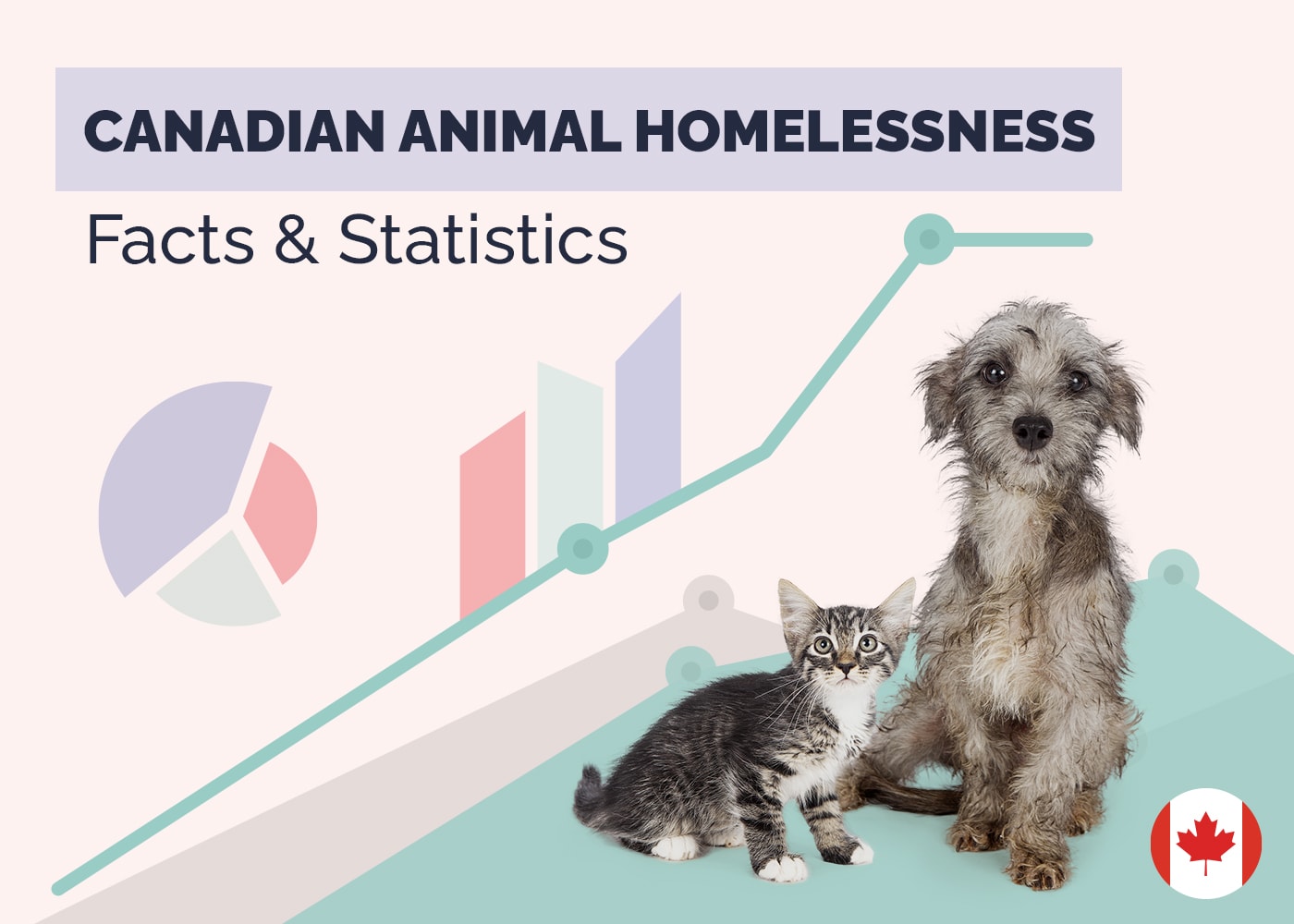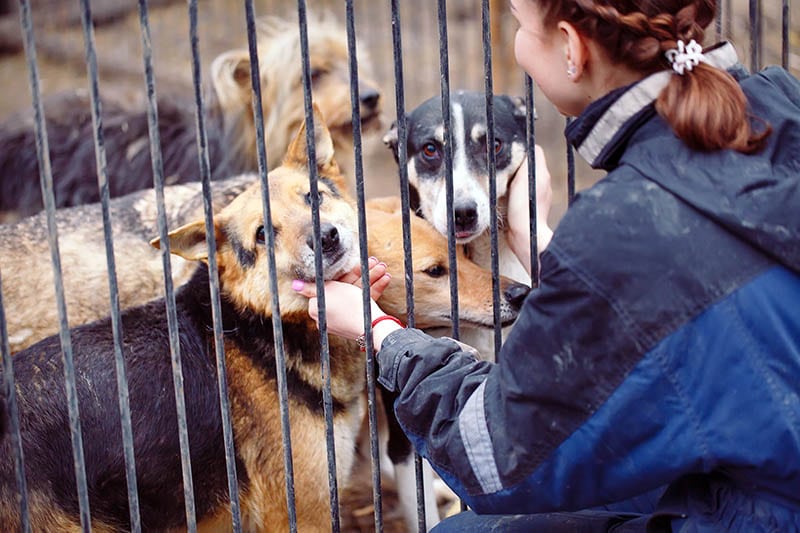15 Shocking Canadian Animal Homelessness Statistics: 2024 Update

Updated on

Click to Skip Ahead
Note: This article’s statistics come from third-party sources and do not represent the opinions of this website.
Canada’s 40 million people are pet lovers with 16.5 million pet cats and dogs alone, and likely millions more pets taking into account other animals like fish, birds, and reptiles. Unfortunately, as in any country, there are also a lot of strays and abandoned pets, along with feral animals that have never had a home but still live in close proximity to the human population. There is no single register of homeless animals or adoptions, but human societies and humane groups do try to keep track of numbers as well as the reasons for homelessness and the ultimate fate of animals in shelters.
Shelters provide an invaluable service to homeless animals, as well as to the people that need to surrender their animals and those looking to adopt new pets. And they face very difficult conditions, especially as 2022 saw a significant increase in the number of animals that were surrendered or handed over to the centers.
Below, we look at 15 statistics relating to animal homelessness in Canada, including the impact of the Covid pandemic and the difficult economic times that many people are facing.
Top 15 Canadian Animal Homelessness Statistics
- There are 8.5 million pet cats & 7.9 million pet dogs in Canada.
- 60% of Canadian households have at least one pet.
- There are approximately 1.3 million homeless cats in Canada.
- Humane societies & SPCAs take around 20,000 dogs & 60,000 cats a year.
- 40,000 animals enter shelters every year in Ontario alone.
- Typically, Canadian shelters are around 70% full.
- 42% of dogs in shelters are strays.
- 50% of cats in shelters are strays.
- Cats generally stay in shelters for 12 days, & dogs for 9 days.
- A third of animals in shelters are reunited with their owners.
- 62% of cats in shelters are adopted.
- Approximately 10% of shelter dogs are euthanized.
- 3.7 million Canadians got new pets during the Pandemic.
- There has been a 60% increase in animal homelessness since Covid 19.
- Most surrendered pets are being surrendered due to cost issues or a change in circumstances.

General Pet Statistics
1. There are 8.5 million pet cats & 7.9 million pet dogs in Canada.
(Statista)
Pets can provide companionship, entertainment, and can even encourage owners to get fit, as we saw during Covid lockdowns. They are popular with people of all ages, make a great addition to a family, and are also ideal for single owners and couples. Such is our love of pets, Canada’s population of nearly 40 million people owns approximately 8.5 million pet cats and 7.9 million pet dogs.

2. 60% of Canadian households have at least one pet.
(Financial Post)
The number of pets means that 6 in 10 Canadian households has at least one pet, although many households own two or more animals and of different types.
3. There are approximately 1.3 million homeless cats in Canada.
(Cats and Birds)
Unfortunately, not all cats and dogs have a stable home life with many either surrendered to shelters or living as strays or ferals. A stray animal is one that has previously lived in a home but has escaped or no longer has a family. A feral has never had a home and lives outdoors. Both are considered homeless, and there are estimated to be around 1.3 million homeless cats across the country. Cats are prolific breeders: a single female cat can have two or even three litters a year with an average of four kittens per litter and most cats can breed throughout their entire lives.
This means that a single, unneutered female cat could have 120 kittens or more over its lifetime, and each female kitten it produces could have the same number of kittens itself.

Animal Intake
4. Humane societies & SPCAs take around 20,000 dogs & 60,000 cats a year.
(Humane Canada 1)
The SPCA is the Society for the Prevention of Cruelty to Animals and is the single largest humane society in Canada with centers in most cities and states. The group keeps records of the number of animals it takes in and adopts out, and also conducts surveys of some other humane societies to give a picture of the state of animal homelessness in the country. According to its figures, the SPCA and humane societies take in 20,000 dogs and 60,000 cats a year. These figures do not include independent shelters and rescues, of which there are likely hundreds, so the figures could be much higher than this.
5. 40,000 animals enter shelters every year in Ontario alone.
(Toronto Humane Society)
Ontario is Canada’s most populous state and is home to more than a third of the country’s population. According to the Toronto Humane Society, 40,000 animals enter shelters in Ontario every single year. If you adjust according to population alone, this means an estimated 120,000 animals enter shelters nationwide every year. This figure includes dogs and cats, but it may include the unfortunate animals that bounce in and out of shelters several times before hopefully finding a forever home.

6. Typically, Canadian shelters are around 70% full.
(Humane Canada 2)
The capacity of a homeless animal shelter is the number of cats and dogs it can have at any time. Although the figure has increased over the past couple of years, Canada’s shelters usually operate at about 70% capacity with spikes in capacity figures at certain times.
7. 42% of dogs in shelters are strays.
(Humane Canada 3)
There are various reasons why animals end up in shelters. They can be surrendered by their owner, found as strays, or they may have been taken in as a result of an animal cruelty case or report. A small number of animals are also born in the shelters. More than 4 in 10 dogs in Canadian shelters were taken in as strays, which means that they have run away, got lost, or have been left on the streets by their owners. Shelters attempt to locate the original owner, typically through the use of pet microchipping, and will usually hold the animal for some time before looking to rehome it.

8. 50% of cats in shelters are strays.
(Humane Canada 3)
The percentage of shelter cats that are strays is even higher, accounting for half of all feline shelter residents. Some cats are allowed to roam outdoors and while most of them find their way home, they can stray too far or get lost and not be able to find their way home, leading to the cat becoming stray.
Outcomes
9. Cats generally stay in shelters for 12 days, & dogs for 9 days.
(Humane Canada 2)
Ideally, stray animals will be reunited with their owners, and other animals adopted as quickly as possible. Long periods in shelters can cause anxiety and stress and may lead to physical and mental problems for the animals concerned. On average, cats stay in shelters for 12 days before being claimed or rehomed. Dogs last 9 days. Some animals are easier to rehome than others. Puppies and kittens tend to be adopted very quickly, and small to medium breeds of dogs have the best chance of finding a new home. Unfortunately, black cats tend to be left behind, while giant dog breeds and those that are perceived as having behavioral issues also struggle to find new families.

10. A third of animals in shelters are reunited with their owners.
(Humane Canada 1)
Happily, most stray animals are reunited with their owners. Approximately one in three of all animals that find their way into shelters are reunited with their original owners. This figure includes those that are considered feral or that have been surrendered: animals that definitely won’t be reunited with their old owners.
11. 62% of cats in shelters are adopted.
(Humane Canada 1)
Nearly two-thirds of cats in shelters are adopted and find their way into new families. Some of these cats do return to the shelter because they don’t settle into the new home or because they weren’t what the new owner was expecting.

12. Approximately 10% of shelter dogs are euthanized.
(Humane Canada 1)
It isn’t all good news for animals that find their way into shelters. Because of high occupancy rates, and also because some animals have been surrendered because they are aggressive or have serious and expensive health conditions, some animals are euthanized. According to statistics, one in ten animals in shelters are euthanized rather than adopted or claimed. No-kill shelters do exist, and these promise that no healthy animal will be put down.
The Covid Effect
13. 3.7 million Canadians got new pets during the Pandemic.
(Global News)
Our pets can provide companionship. They can help reduce feelings of loneliness and studies have shown that they can help owners with anxiety and depression. These benefits saw pet ownership become especially popular during Covid 19, especially as the country went into lockdown and people were working from home. As a result, 3.7 million Canadians got new pets during the Pandemic. Arguably, many of these new owners would have got new pets anyway, but the figure is higher than is typical.

14. There has been a 60% increase in animal homelessness since Covid 19.
(Global News)
Unfortunately, as lockdowns ended and people returned to work, this meant that new pets were left at home alone. Many of those pets were left alone for the first time and found it difficult to be left for several hours at a time causing separation anxiety and potential behavioral problems. As owners discovered that they no longer had the time to dedicate to their new pets, more dogs and cats were handed over to shelters. According to some figures, there has been a 60% increase in animal homelessness rates since Covid.
15. Most surrendered pets are being surrendered due to cost issues or a change in circumstances.
(Global News)
A change in circumstances has been one of the most common reasons for owners handing their pets over to humane societies, caused as a result of Covid and its subsequent lockdowns. However, the most common reason given by owners surrendering their pets has been that they can’t afford to keep the animal.

Frequently Asked Questions
Why do dogs end up in shelters?
There are a number of reasons why dogs end up in shelters. Owners may no longer be able to care for them due to a change in personal circumstances. Owners that move to a new property might find that the landlord is not accommodating of dogs, while the arrival of a new baby can push a lot of owners to surrender their dogs. Other times, dogs escape from their home and fail to find their way back. Some dogs are, unfortunately, abandoned by their owners who no longer want to care for them. And some dogs are born on the streets, so have never had a home or family.

What is the difference between stray & feral?
Stray and feral animals are considered homeless. Whereas a stray animal once had a home but now lives on the streets, a feral animal has never had a home.
What are no-kill shelters?
No-kill shelters are rescue centers and humane shelters that take in animals like any shelter. They are different, though, because they won’t euthanize animals unless there is a medical reason to do so. Some shelters will euthanize animals if they fail to rehome them after a certain amount of time or if they have shown signs of aggression in the past.
What is the most commonly surrendered dog breed?
The breeds that are most commonly surrendered are Staffordshire Pit Bull Terriers. Unfortunately, these are also among the breeds that are least likely to be adopted because they have a reputation for being aggressive. (Calendar Canada)

What are TNR programs?
Some human societies and animal welfare societies operate TNR programs. TNR stands for Trap, Neuter, Return. This means that feral animals are humanly trapped, neutered, and then returned to where they were found. This is most commonly associated with feral animals, and it prevents ferals from giving birth to more litters, therefore reducing the number of feral animals on the streets over time. (Alley Cat Allies)
Conclusion
There are nearly 16 million pet cats and dogs in Canada, with more than 100,000 homeless pets living on the streets or in shelters and rescue centers. And the homeless animal problem only got worse as a result of Covid, with the current cost of living crisis resulting in even more surrenders.
Adopting a pet can give one of these animals a new home, costs less than buying, and there are plenty of animals out there to choose from.
See also: How Many Cats Are There in Canada? 11 Interesting Statistics
Related Reads:
Featured Image Credit: Rami Happonen, Shutterstock









